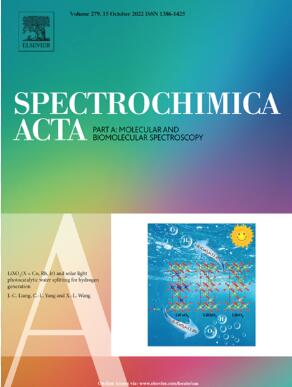Efficient visible-light-active ZnO/Cs0.33WO3/g-C3N4 double Z-type heterojunction photocatalyst for rhodamine B photodegradation
IF 4.3
2区 化学
Q1 SPECTROSCOPY
Spectrochimica Acta Part A: Molecular and Biomolecular Spectroscopy
Pub Date : 2025-05-10
DOI:10.1016/j.saa.2025.126380
引用次数: 0
Abstract
Developing highly efficient photocatalyst systems for the removal of cancer-causing organic dye substances from polluted water and wastewater is now in high demand because of the growing problem of contaminated water. An affordable technique was employed to create a ternary ZnO/Cs0.33WO3/g-C3N4 heterojunction nanocomposite with highly efficient and rapid photodegradation capabilities for degrading rhodamine B (RhB) dye. Using visible-light irradiation, the photocatalytic tests revealed that the proposed ZnO/Cs0.33WO3/g-C3N4 heterojunction nanocomposite is efficiently able to degrade more than 91 % of RhB dye within 15 min, 97.5 % within 20 min, and 99.9 % within 30 min, which is significantly efficient compared to sole ZnO and Cs0.33WO3. The kinetic rate constant of RhB photodegradation catalyzed by the ternary ZnO/Cs0.33WO3/g-C3N4 nanocomposite is assessed to be about 31 times faster than that of Cs0.33WO3 and about 3.5 times faster than that of ZnO. The investigation of the photodegradation mechanism suggested that the ternary ZnO/Cs0.33WO3/g-C3N4 nanocomposite follows a direct Z-scheme mechanism for charge transfer. The creation of a ternary ZnO/Cs0.33WO3/g-C3N4 heterojunction nanocomposite is valuable for increasing the surface area, strengthening the contact between its components, enhancing absorption capacity of visible light, increasing the generation rate of the photoexcited charge carriers, improving the separation efficiency of photogenerated charge carriers, and reducing their undesired recombination rate. As a consequence, the visible-light-mediated degradation of organic dye contaminants is significantly improved.
高效可见光活性ZnO/Cs0.33WO3/g-C3N4双z型异质结光催化剂光降解罗丹明B
由于水污染问题日益严重,开发高效的光催化剂系统以去除受污染的水和废水中的致癌有机染料物质是目前的高需求。采用经济可行的方法制备了具有高效、快速光降解罗丹明B (RhB)染料性能的ZnO/Cs0.33WO3/g-C3N4三元异质结纳米复合材料。在可见光照射下,光催化测试表明,ZnO/Cs0.33WO3/g-C3N4异质结纳米复合材料在15 min、20 min和30 min内对RhB染料的降解率分别为91%、97.5%和99.9%,与单一ZnO和Cs0.33WO3相比,效率显著提高。ZnO/Cs0.33WO3/g-C3N4纳米复合材料催化RhB光降解的动力学速率常数比Cs0.33WO3快约31倍,比ZnO快约3.5倍。光降解机理研究表明,ZnO/Cs0.33WO3/g-C3N4纳米复合材料遵循直接的Z-scheme机制进行电荷转移。制备ZnO/Cs0.33WO3/g-C3N4三元异质结纳米复合材料,对于增加其表面面积、加强组分之间的接触、增强可见光吸收能力、提高光激发载流子的生成速率、提高光生载流子的分离效率、降低其不期望的复合率具有重要意义。因此,可见光介导的有机染料污染物的降解是显着改善。
本文章由计算机程序翻译,如有差异,请以英文原文为准。
求助全文
约1分钟内获得全文
求助全文
来源期刊
CiteScore
8.40
自引率
11.40%
发文量
1364
审稿时长
40 days
期刊介绍:
Spectrochimica Acta, Part A: Molecular and Biomolecular Spectroscopy (SAA) is an interdisciplinary journal which spans from basic to applied aspects of optical spectroscopy in chemistry, medicine, biology, and materials science.
The journal publishes original scientific papers that feature high-quality spectroscopic data and analysis. From the broad range of optical spectroscopies, the emphasis is on electronic, vibrational or rotational spectra of molecules, rather than on spectroscopy based on magnetic moments.
Criteria for publication in SAA are novelty, uniqueness, and outstanding quality. Routine applications of spectroscopic techniques and computational methods are not appropriate.
Topics of particular interest of Spectrochimica Acta Part A include, but are not limited to:
Spectroscopy and dynamics of bioanalytical, biomedical, environmental, and atmospheric sciences,
Novel experimental techniques or instrumentation for molecular spectroscopy,
Novel theoretical and computational methods,
Novel applications in photochemistry and photobiology,
Novel interpretational approaches as well as advances in data analysis based on electronic or vibrational spectroscopy.

 求助内容:
求助内容: 应助结果提醒方式:
应助结果提醒方式:


